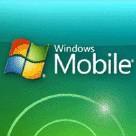This paper presents an implementation of a markerless tracking technique targeted to the Windows Mobile Pocket PC platform. The primary aim of this work is to allow the development of standalone augmented reality applications for handheld devices based on natural feature tracking. In order to achieve this goal, a subset of two computer vision libraries was ported to the Pocket PC platform. They were also adapted to use fixed point math, with the purpose of improving the overall performance of the routines. The port of these libraries opens up the possibility of having other computer vision tasks being executed on mobile platforms. A model based tracking approach that relies on edge information was adopted. Since it does not require a high processing power, it is suitable for constrained devices such as handhelds. The OpenGL ES graphics library was used to perform computer vision tasks, taking advantage of existing graphics hardware acceleration. An augmented reality application was created using the implemented technique and evaluations were done regarding tracking performance and accuracy
翻译:本文介绍了针对Windows Moved Pocket PC平台的无标识跟踪技术的实施情况,这项工作的主要目的是开发基于自然特征跟踪的手持设备独立增强的现实应用软件,为实现这一目标,将两个计算机视觉图书馆的子集移植到Pocket PC平台,还进行了调整,以使用固定点数学,目的是改善日常工作的总体性能。这些图书馆的港口开辟了在移动平台上执行其他计算机视觉任务的可能性。采用了基于边缘信息的模型跟踪方法。由于不需要高处理力,它适合手持设备等受限设备。 OpenGLES 图形图书馆被用于执行计算机视觉任务,利用现有图形硬件加速。利用实施的技术创建了扩大的现实应用软件,并在跟踪性能和准确性方面进行了评估。



